

Brainwave entrainment. Brainwave Entrainment is any practice that aims to cause brainwave frequencies to fall into step with a periodic stimulus having a frequency corresponding to the intended brain-state (for example, to induce sleep), usually attempted with the use of specialized software.
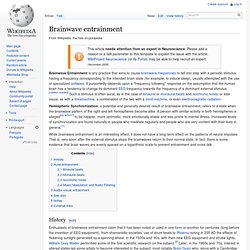
It purportedly depends upon a "frequency following" response on the assumption that the human brain has a tendency to change its dominant EEG frequency towards the frequency of a dominant external stimulus. [citation needed] Such a stimulus is often aural, as in the case of binaural or monaural beats and isochronic tones, or else visual, as with a dreamachine, a combination of the two with a mind machine, or even electromagnetic radiation. Hemispheric Synchronization, a potential and generally desired result of brainwave entrainment, refers to a state when the brainwave pattern of the right and left hemispheres become alike.
A person with similar activity in both hemispheres is alleged[by whom?] History[edit] Notes[edit] Jim Robbins. Mind in Life - Evan Thompson. FRANCISCO J. VARELA: 1946-2001. THE EMERGENT SELF. "Why do emergent selves, virtual identities, pop up all over the place, creating worlds, whether at the mind/body level, the cellular level, or the transorganism level?

This phenomenon is something so productive that it doesn't cease creating entirely new realms: life, mind, and societies. Yet these emergent selves are based on processes so shifty, so ungrounded, that we have an apparent paradox between the solidity of what appears to show up and its groundlessness. That, to me, is the key and eternal question. " FRANCISCO VARELA The Emergent Self [6.5.01] Francisco Varela died on May 28 at his home in Paris. According to his friend and collaborator Evan Thompson "I am told he died completely calm and at peace. Francisco Varela : Human Consciousness : Articles. ‘Neurophenomenology : A Methodological Remedy for the Hard Problem’ Journal of Consciousness Studies, "Special Issues on the Hard Problems", J.Shear (Ed.)
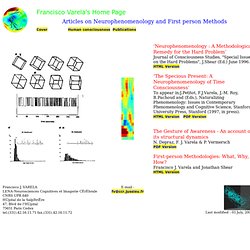
June 1996. HTML Version ‘The Specious Present: A Neurophenomenology of Time Consciousness’ To appear in:J.Petitot, F.J.Varela, J. HTML Version PDF Version. Francisco Varela « Neurophenomenology. (Part I is here, and part III is here) In certain respects, development of the view that embodied experience is crucial to understanding the mind and brain reached a nadir in the period after World War II, at least within psychology.
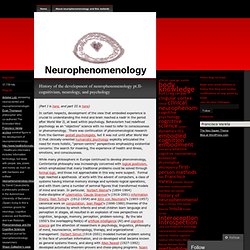
Behaviorism had redefined psychology as an “objective” science with no need to refer to consciousness or phenomenology. Antoine Lutz's Homepage. I am currently an associate scientist at the Waisman Lab for Brain Imaging & Behavior at the University of Wisconsin-Madison.
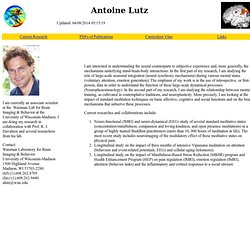
I am doing my research in collaboration with Prof. R. J. Davidson and several researchers from his lab. Contact: Waisman Laboratory for Brain Imaging & Behavior University of Wisconsin-Madison 1500 Highland Avenue Madison, WI 53703-2280 (tel) (1).608.262.8705 (fax) (1).608.262.9440 alutz@wisc.edu I am interested in understanding the neural counterparts to subjective experience and, more generally, the mechanisms underlying mind-brain-body interactions. Current researches and collaborations include: The Neuroscience of Emotions. Mapping the human brain connectivity. Paul Thompson's Research Publications. The brain's center of reasoning and problem solving is among the last to mature, a new study graphically reveals.
The decade-long magnetic resonance imaging (MRI) study of normal brain development, from ages 4 to 21, by researchers at NIH's National Institute of Mental Health (NIMH) and University of California Los Angeles (UCLA) shows that such "higher-order" brain centers, such as the prefrontal cortex, don't fully develop until young adulthood. Morality Study Narrows Gap Between Mind And Brain. Our brains are wired so we can better hear ourselves speak, new study shows. Like the mute button on the TV remote control, our brains filter out unwanted noise so we can focus on what we’re listening to.
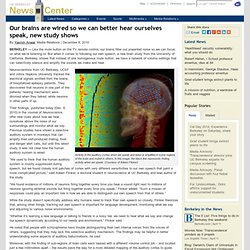
But when it comes to following our own speech, a new brain study from the University of California, Berkeley, shows that instead of one homogenous mute button, we have a network of volume settings that can selectively silence and amplify the sounds we make and hear. Brain+Illusions.jpg (JPEG Image, 950x848 pixels) - Scaled (71. Clearing the Mind: How the Brain Cuts the Clutter.
Newly discovered neurons in the front of the brain act as the bouncers at the doors of the senses, letting in only the most important of the trillions of signals our bodies receive.

Problems with these neurons could be the source of some symptoms of diseases like attention deficit disorder and schizophrenia. "The brain doesn't have enough capacity to process all the information that is coming into your senses," said study researcher Julio Martinez-Trujillo, of McGill University in Montreal. "We found that there are some cells, some neurons in the prefrontal cortex, which have the ability to suppress the information that you aren't interested in.
They are like filters. " Humans are constantly taking in huge streams of data from each of our senses. A cluttered mind This "brain clutter," or inability to filter out unnecessary information, is a possible mechanism of diseases like attention deficit hyperactivity disorder (ADHD) and schizophrenia. Reconstructing visual experiences from brain activity evoked by natural movies. - GallantLabUCB. Whole Brain Emulation: The Logical Endpoint of Neuroinformatics?
The riddle of free will goes unsolved. Graham Lawton, deputy magazine editor Neuroscientist Michael Gazzaniga's Who's In Charge? Free will and the science of the brain is fascinating, but doesn't deliver on its promise ABOUT half way through this fascinating book, Michael Gazzaniga harks back to his previous one, Human. The Brain is Wider Than the Sky by Bryan Appleyard – review. MRI images are modern equivalent of Galileo's drawings of the moon.
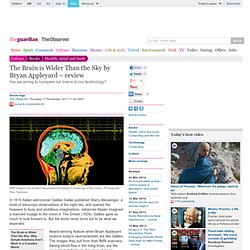
Photograph: Rex Features In 1610 Italian astronomer Galileo Galilei published Starry Messenger, a book of telescopic observations of the night sky, and opened the heavens to busy and ambitious imaginations. Johannes Kepler imagined a manned voyage to the moon in The Dream (1634). Galileo gave us much to look forward to. But the world never turns out to be what we expected. The Brain is Wider Than the Sky: Why Simple Solutions Don't Work in a Complex World by Bryan Appleyard Tell us what you think: Star-rate and review this book Award-winning feature writer Bryan Appleyard reckons today's neuroscientists are like Galileo. Patricia Churchland on Neurophilosophy. A Glorious Piece of Meat: The Neural Basis of Consciousness. Laboratory of Visual Neuroscience : : Susana Martinez-Conde, Director.